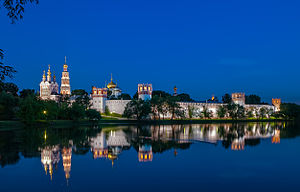Novodevichy Convent
You can help expand this article with text translated from the corresponding article in Russian. (January 2017) Click [show] for important translation instructions.
|
 Novodevichy Convent at night | |
| Monastery information | |
|---|---|
| Order | Russian Orthodox Church |
| Established | 1524 |
| People | |
| Founder(s) | Vasili III of Russia |
| Site | |
| Location | Moscow, Russia |
| Coordinates | 55°43′34″N 37°33′22″E / 55.72611°N 37.55611°E |
Europe and North America | |
Novodevichy Convent, also known as Bogoroditse-Smolensky Monastery (
Structure and monuments
The Convent is situated in the south-western part of the historic town of Moscow. The Convent territory is enclosed within walls and surrounded by a park, which forms the buffer zone. The park is limited by the urban fabric of the city on the north and east sides. On the west side, it is limited by the
The oldest structure in the convent is the six-pillared five-domed Smolensky Cathedral, dedicated to the icon Our Lady of Smolensk. It is situated in the centre of the axes between the two entrance gates. Extant documents date its construction to 1524–1525; yet its lofty ground floor, magisterial proportions, and projecting central gable are typical of monastery cathedrals built at the behest of Ivan the Terrible. Most scholars agree that the cathedral was rebuilt in the 1550s or 1560s. It was formerly ringed by four smaller chapels, in an arrangement reminiscent of the Cathedral of the Annunciation in the Kremlin. Its frescos are among the finest in Moscow.
The cathedral may be a focal point of the convent, but there are many other churches. Most date from the 1680s, when the convent was thoroughly renovated at the behest of the regent
An arresting slender
History of the convent
Muscovite period
This section needs additional citations for verification. (January 2019) |
The Novodevichy Convent housed many ladies from the Russian royal families and
Imperial period


In the mid-17th century,
In 1812,
In 1871, the Filatyev brothers donated money for a shelter-school for the orphans of "ignoble origins". Also, the convent housed two almshouses for nuns and lay sisters. In early 1900s, the Cathedral was surveyed and restored by architect and preservationist Ivan Mashkov. By 1917, there were 51 nuns and 53 lay sisters residing in the Novodevichy Convent.

Soviet period and beyond
In 1922, the Bolsheviks closed down the Novodevichy Convent (the cathedral was the last to be closed, in 1929) and turned it into the Museum of Women's Emancipation. By 1926, the monastery had been transformed into a history and art museum. In 1934, it became affiliated with the State Historical Museum. Most of its facilities were turned into apartments, which spared the convent from destruction.
In 1943, when
In 1994, nuns returned to the convent, which is currently under the authority of the Metropolitan of Krutitsy and Kolomna. Some of the churches and other monastic buildings are still affiliated with the State Historical Museum. In 1995, religious services resumed in the convent on patron saint's days.
UNESCO World Heritage Site proclamation

In 2004, the Novodevichy Convent was proclaimed a
Bell tower fire
On March 15, 2015, a fire engulfed the convent's tallest bell tower, which pinnacles at a height of 72 meters. The monastery had been undergoing major repair work and was covered in scaffolding.[3] It took firefighters almost three hours to put out the fire. The blaze reportedly affected an area of three hundred square metres, but it was restricted to the scaffolding and did not do any damage to the historical building itself. The speculated cause of the fire was a short circuit caused by heat guns used for drying the facade. The press service for the Moscow cultural heritage department blamed the fire on the firm doing the restoration work. However, Russian Deputy Culture Minister Grigory Pirumov said heat guns were not in use on the territory of the convent and the bell tower had been disconnected from the mains power supply.[4]
Necropolis and cemetery

The
In 1898–1904, the so-called Novodevichy Cemetery was established outside the south wall. Anton Chekhov was one of the first notables to be interred at the new cemetery, and Nikolai Gogol was later reburied there too. During the Soviet epoch, it was turned into the most high-profile cemetery in the Soviet Union, with Peter Kropotkin, Nikita Khrushchev, Sergei Prokofiev, Dmitri Shostakovich, Konstantin Stanislavski, Boris Yeltsin, and Mstislav Rostropovich being interred there.
References
- ^ a b "World Heritage List: Ensemble of the Novodevichy Convent". UNESCO. United Nations. Retrieved March 17, 2015.
- ^ "The origins and history of Novodevichy Convent – [English]".
- ^ Amos, Howard (March 15, 2015). "Moscow's historic Novodevichy Convent catches fire close to Kremlin". The Daily Telegraph. Retrieved March 16, 2015.
- ^ "Fire in Novodevichy Convent bell tower did not damage building". Interfax. March 16, 2015. Retrieved March 16, 2015.
Further reading
- Harrison, Peter (2004). Castles of God: Fortified Religious Buildings of the World. Boydell Press. ISBN 1-84383-066-3
- Semler, Helen (1987). Discovering Moscow: Architecture, History, and Art. Hippocrene Books. ISBN 0-87052-131-4
External links
- Official website

- Evaluation of the convent by UNESCO team
- Latest photos of Novodevichy Convent and webcam
